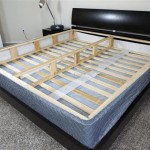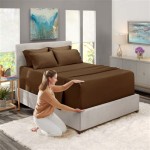Choosing the Right Pillows for a King Size Bed
Selecting pillows for a king size bed requires careful consideration to ensure both comfort and proper spinal alignment. The larger dimensions of a king size bed necessitate a thoughtful approach to pillow selection, taking into account factors such as sleeping position, fill material, and personal preferences. A well-chosen pillow can contribute significantly to a restful night's sleep, while an unsuitable pillow can lead to discomfort, neck pain, and disrupted sleep patterns.
The market offers a wide array of pillow options, each with unique characteristics that cater to different needs. Navigating these options effectively requires an understanding of the various types of pillows available and their respective benefits. Furthermore, considering the size and dimensions of a king size bed is critical in determining the number of pillows needed to create a balanced and aesthetically pleasing sleeping environment.
Understanding Fill Material Options
The fill material of a pillow is a primary determinant of its comfort level, support, and longevity. Common fill materials include down, feathers, down alternatives, memory foam, and latex, each possessing distinct qualities that appeal to different sleepers. Understanding the characteristics of each fill material is essential in making an informed decision.
Down pillows, traditionally considered a luxury option, are filled with the soft plumage found beneath the outer feathers of ducks or geese. Down offers exceptional softness, lightness, and warmth. The fill power, a measure of the down's ability to loft and trap air, indicates the quality of the down. Higher fill power equates to a fluffier and more durable pillow. However, down pillows may not be suitable for individuals with allergies or those who prefer firmer support.
Feather pillows are typically less expensive than down pillows and are filled with the outer feathers of ducks or geese. While offering some support, feather pillows tend to be firmer and less pliable than down pillows. The quills of the feathers can sometimes poke through the fabric, leading to discomfort. Feather pillows also tend to flatten over time and require frequent fluffing to maintain their shape.
Down alternative pillows are filled with synthetic materials, such as polyester fibers, designed to mimic the feel of down. These pillows are hypoallergenic and generally more affordable than down pillows. Down alternative pillows offer a range of firmness levels and are suitable for individuals with allergies or sensitivities to down. However, they may not be as breathable or durable as down pillows.
Memory foam pillows are made from viscoelastic foam that conforms to the shape of the head and neck, providing customized support. Memory foam pillows are known for their pressure-relieving properties and are often recommended for individuals with neck pain or back pain. Memory foam pillows are available in various shapes and sizes, including contoured pillows designed to promote proper spinal alignment. However, memory foam pillows can sometimes retain heat, which may be uncomfortable for some sleepers.
Latex pillows are made from natural or synthetic latex rubber. Latex pillows offer a resilient and supportive feel. They are known for their breathability and durability. Latex pillows are also hypoallergenic and resistant to dust mites. Natural latex pillows are made from the sap of rubber trees and are considered an eco-friendly option. Latex pillows are available in various densities and shapes, offering a range of support levels.
Considering Sleeping Position
Sleeping position plays a crucial role in determining the type of pillow that will provide optimal support and comfort. Different sleeping positions require different levels of support to maintain proper spinal alignment. Side sleepers, back sleepers, and stomach sleepers each have unique needs that should be considered when selecting pillows for a king size bed.
Side sleepers generally require thicker pillows to fill the space between the head and the mattress, keeping the spine aligned. A pillow with a firm or medium-firm density is often recommended for side sleepers. Contoured pillows designed to support the neck and shoulders can also be beneficial for side sleepers. The pillow should be thick enough to prevent the head from tilting downward, which can strain the neck muscles.
Back sleepers typically require thinner pillows to maintain a neutral spinal alignment. A pillow that is not too thick will prevent the head from being pushed forward, which can cause neck pain. A pillow with a medium-soft or medium density is often recommended for back sleepers. Pillows with a contoured shape or cervical support can also be beneficial for back sleepers, providing additional support to the neck.
Stomach sleepers generally require very thin pillows or no pillow at all to avoid arching the back and straining the neck. A pillow that is too thick can force the head up and back, leading to discomfort and pain. If a pillow is desired, a very thin and soft pillow is recommended to minimize strain on the neck and back. Alternatively, a small pillow or rolled towel can be placed under the stomach to help maintain spinal alignment.
Determining the Number and Arrangement of Pillows
The number and arrangement of pillows on a king size bed is a matter of personal preference and aesthetic considerations. However, a balanced and visually appealing arrangement can enhance the overall comfort and style of the bedroom. Common arrangements include using two king size pillows, three standard size pillows, or a combination of different sizes and shapes.
Using two king size pillows is a simple and symmetrical arrangement that provides ample support for two sleepers. This arrangement is particularly suitable for couples who prefer individual pillows. King size pillows are typically 20 inches by 36 inches, providing a comfortable and spacious sleeping surface. This arrangement is straightforward and easy to maintain, creating a clean and uncluttered look.
Using three standard size pillows can create a more layered and visually interesting arrangement. This arrangement allows for greater flexibility in terms of pillow types and densities. For example, one pillow could be filled with down, another with memory foam, and a third with a down alternative. This provides options for different comfort preferences. Standard size pillows are typically 20 inches by 26 inches and offer a more compact and versatile option compared to king size pillows.
Combining different sizes and shapes of pillows can create a more personalized and decorative arrangement. This arrangement allows for the incorporation of decorative pillows in addition to functional sleeping pillows. For example, two king size pillows could be placed at the back of the bed, followed by two standard size pillows, and then a few smaller decorative pillows in front. This arrangement adds depth and visual interest to the bed while also providing ample support for sleeping. Decorative pillows can be chosen to complement the color scheme and style of the bedroom, enhancing the overall aesthetic appeal.
In addition to the number and arrangement of pillows, the type of pillowcases used can also impact comfort and aesthetics. Pillowcases are available in a variety of materials, including cotton, silk, and linen. Cotton pillowcases are breathable and durable, while silk pillowcases are known for their softness and smoothness. Linen pillowcases are naturally cooling and absorbent. The choice of pillowcase material depends on personal preference and the desired level of comfort.
Regularly cleaning and maintaining pillows is essential for hygiene and longevity. Pillows should be washed or dry cleaned according to the manufacturer's instructions. Using pillow protectors can help to prevent dust mites and allergens from accumulating in the pillows. Pillows should also be replaced every one to two years, or sooner if they become flattened or lumpy. Proper care and maintenance can extend the life of pillows and ensure a comfortable and healthy sleeping environment.

How To Arrange Throw Pillows On King Bed All Handmade Home Decor Including Pillow Covers The Global Stitch

How To Arrange King Size Bed Pillows Casa Watkins Living

How To Style Pillows On A King Size Bed At Home In Love

How To Arrange Throw Pillows On King Bed All Handmade Home Decor Including Pillow Covers The Global Stitch

Bed Pillow Arrangements You Will Love Stonegable

How To Arrange King Size Bed Pillows Casa Watkins Living

How To Style Pillows On A King Size Bed At Home In Love

How To Style A King Size Bed The Sommer Home

An Easy Formula For Styling Bed Pillows She Holds Dearly

How To Style Pillows On A King Size Bed At Home In Love








